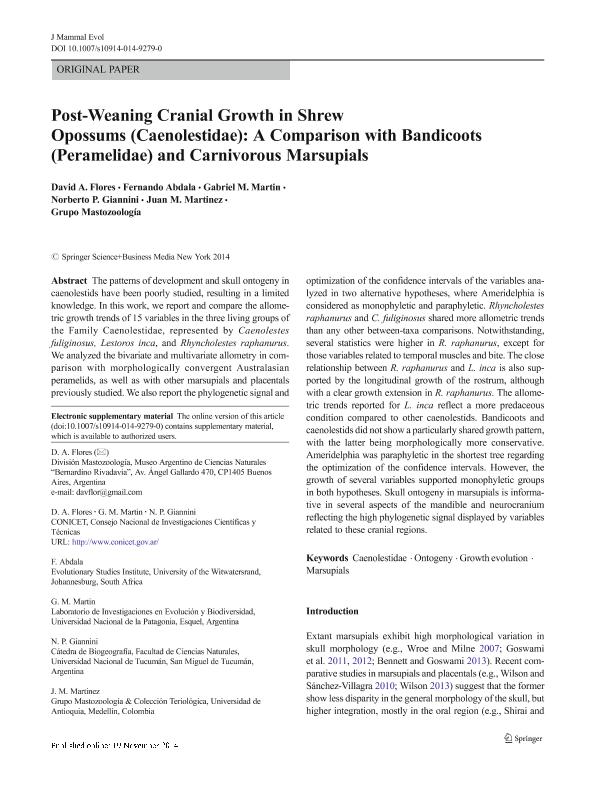Artículo
Post-Weaning Cranial Growth in Shrew Opossums (Caenolestidae): A Comparison with Bandicoots (Peramelidae) and Carnivorous Marsupials
Flores, David Alfredo ; Abdala, Fernando; Martin, Gabriel Mario
; Abdala, Fernando; Martin, Gabriel Mario ; Giannini, Norberto Pedro
; Giannini, Norberto Pedro ; Martinez, J. M.; Grupo Mastozoología
; Martinez, J. M.; Grupo Mastozoología
 ; Abdala, Fernando; Martin, Gabriel Mario
; Abdala, Fernando; Martin, Gabriel Mario ; Giannini, Norberto Pedro
; Giannini, Norberto Pedro ; Martinez, J. M.; Grupo Mastozoología
; Martinez, J. M.; Grupo Mastozoología
Fecha de publicación:
09/2015
Editorial:
Springer
Revista:
Journal of Mammalian Evolution
ISSN:
1064-7554
e-ISSN:
1573-7055
Idioma:
Inglés
Tipo de recurso:
Artículo publicado
Clasificación temática:
Resumen
The patterns of development and skull ontogeny in caenolestids have been poorly studied, resulting in a limited knowledge. In this work, we report and compare the allometric growth trends of 15 variables in the three living groups of the Family Caenolestidae, represented by Caenolestes fuliginosus, Lestoros inca, and Rhyncholestes raphanurus. We analyzed the bivariate and multivariate allometry in comparison with morphologically convergent Australasian peramelids, as well as with other marsupials and placentals previously studied. We also report the phylogenetic signal and optimization of the confidence intervals of the variables analyzed in two alternative hypotheses, where Ameridelphia is considered as monophyletic and paraphyletic. Rhyncholestes raphanurus and C. fuliginosus shared more allometric trends than any other between-taxa comparisons. Notwithstanding, several statistics were higher in R. raphanurus, except for those variables related to temporal muscles and bite. The close relationship between R. raphanurus and L. inca is also supported by the longitudinal growth of the rostrum, although with a clear growth extension in R. raphanurus. The allometric trends reported for L. inca reflect a more predaceous condition compared to other caenolestids. Bandicoots and caenolestids did not show a particularly shared growth pattern, with the latter being morphologically more conservative. Ameridelphia was paraphyletic in the shortest tree regarding the optimization of the confidence intervals. However, the growth of several variables supported monophyletic groups in both hypotheses. Skull ontogeny in marsupials is informative in several aspects of the mandible and neurocranium reflecting the high phylogenetic signal displayed by variables related to these cranial regions.
Palabras clave:
Marsupiales
,
Ontogenia
,
Evolución
Archivos asociados
Licencia
Identificadores
Colecciones
Articulos(MACNBR)
Articulos de MUSEO ARG.DE CS.NAT "BERNARDINO RIVADAVIA"
Articulos de MUSEO ARG.DE CS.NAT "BERNARDINO RIVADAVIA"
Citación
Flores, David Alfredo; Abdala, Fernando; Martin, Gabriel Mario; Giannini, Norberto Pedro; Martinez, J. M.; et al.; Post-Weaning Cranial Growth in Shrew Opossums (Caenolestidae): A Comparison with Bandicoots (Peramelidae) and Carnivorous Marsupials; Springer; Journal of Mammalian Evolution; 22; 3; 9-2015; 285-303
Compartir
Altmétricas



